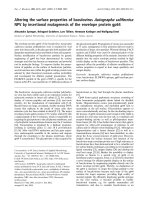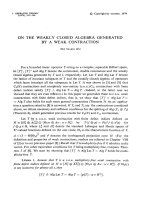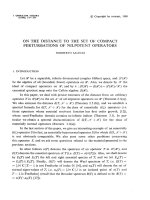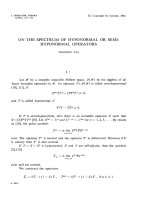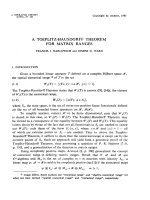Báo cáo toán học: "Maximizing the Stability Radius of Discrete-Time Linear Positive Systems by Linear Feedbacks" ppsx
Bạn đang xem bản rút gọn của tài liệu. Xem và tải ngay bản đầy đủ của tài liệu tại đây (138.75 KB, 11 trang )
Vietnam Journal of Mathematics 33:2 (2005) 161–171
Maximizing the Stability Radius
of Discrete-Time Linear Positive Systems
by Linear Feedbacks
Nguyen Khoa Son
1
andNguyenDinhHuy
2
1
Institute of Mathematics, 18 Hoang Quoc Viet Road, 10307 Hanoi, Vietnam
2
University of Technology, 268 Ly Thuong Kiet,
Ho Chi Minh City,Vietnam
Received April 15, 2004
Revised June 15, 2004
Abstract. In this paper we shall prove a theorem on the existence of a linear feedback
maximizing the real stability radius of a linear positive discrete-time system while
preserving positivity of the system.
1. Introduction
Consider a dynamical system described by the following linear difference equa-
tion
x(t +1)=Ax(t),t∈ N, (1)
where A ∈ R
n×n
,x(t) ∈ R
n
and N = {0, 1, 2, }. Assume that the system (1)
is Schur stable, i.e. the spectrum σ(A)ofA lies in the open unit disk
D
1
= {s ∈ C; |s| < 1},
or, equivalently,
ρ(A) < 1,
where ρ(A) is the spectral radius of A. Assume that the matrix A is subjected
to perturbation of the form
A → A + DΔE,
162 Nguyen Khoa Son and Nguyen Dinh Huy
where D ∈ R
n×l
and E ∈ R
q×n
are given matrices defining the structure of the
perturbations and Δ ∈ R
l×q
is unknown disturbance matrix. Then the stability
radius of the matrix A with respect to perturbations of the structure (D, E)is
defined by
r
K
(A)=r
K
(A; D, E)=inf{Δ;Δ∈ K
l×q
,ρ(A + DΔE) ≥ 1},
K = R, C.
Thus, the stability radii measure the robustness of stability of the systems
under complex and real perturbations, respectively. From practical point of
view, the system is ”better” if its stability radius is ”larger”.
It is a well-known fact that, for any given real triple (A, D, E), the com-
plex stability radius r
C
(A; D, E) is easier to analyze than the real stability radius
r
R
(A; D, E), although, at the first sight, only the stability radii under real pertur-
bations seem to be of practical interest. It has been shown that the computation
of the complex stability radius is reduced to a global optimization problem of a
Lipschitz function over the real line. Namely, the following formula holds [6]
r
C
(A; D, E)=
1
max
ω∈R
E(ıωI − A)
−1
D
. (2)
Meanwhile, the problem of deriving the computable formulae for the real stability
radius is a much more difficult problem and has been solved by Qiu, Bernhards-
son, Doyle and others [17], who established an explicit formula for real stability
radius involving a global minimization problem over R
2
.
The situation looks much simpler for positive linear systems. Indeed, we
have the following [18]
Theorem 1.1. Suppose that K
l
, K
q
are provided with m onotonic norms, K = R
or C and (A, D, E) ∈ R
n×n
+
× R
n×l
+
× R
q×n
+
.Ifρ(A) < 1 ,then
r
C
(A; D, E)=r
R
(A; D, E)=r
R
+
(A; D, E)=E(I − A)
−1
D
−1
,
(where ·is the operator norm).
The above result has been extended to linear positive systems in infinite-
dimentional spaces [4, 19],to systems subjected to perturbations of more general
forms [11, 20] and, more recently, to positive retarded systems described by
linear functional differential equations [21, 16].
In this paper, for a stabilizable linear system of the form x(t +1)= Ax(t)+
Bu(t),t∈ N = {0, 1, 2, } with non-negative matrices A, B, we look for a linear
stabilizing feedback u = Fx such that the closed-loop system x(t +1)= (A +
BF)x(t),t ∈ N would have a maximal stability radius while remains a positive
one: A + BF ≥ 0. We remark that the problem of stabilization of positive
systems has recently attracted a good deal of attention of researchers in control
theory, see e.g. [15].
Maximizing the Stability Radius 163
2. Problem of Optimizing the Stability Radius by Linear Feedbacks
Consider a linear controlled system described by a difference equation of the
form
x(t +1)=Ax(t)+Bu(t),t∈ N = {0, 1, 2, }, (3)
where A ∈ R
n×n
+
,B ∈ R
n×m
+
are matrices with nonnegative entries. Suppose
that the system is stabilizable i.e. there exists a linear state feedback u =
Fx,F ∈ R
m×n
such that
σ(A − BF) ⊂ D
1
:= {s ∈ C : |s| < 1}, (4)
or equivalently
ρ(A − BF) < 1. (5)
Assume that the system is subjected to perturbation of the form
A → A + DΔE, (6)
where (D, E) ∈ R
n×l
× R
q×n
are given structure matrices.
Our aim is to dertermine the supremum of the real stability radius of the system
(3) which can be achieved by linear state feedback u = Fx,F ∈ R
m×n
, without
destroying positivity of the system.
Problem 2.1.
maximize r
R
(A − BF; D, E)
subject to F ∈ R
m×n
,A− BF ≥ 0,
σ(A − BF) ⊂ D
1
.
Let denote by F the set of all stabilizing state feedbacks preserving positivity
of system (3)
F := {F ∈ R
m×n
: A − BF ≥ 0,σ(A − BF) ⊂ D
1
}. (7)
In general, F is not bounded. This is shown by the following example:
A =
00
00
,B=
1
0
,F
k
=[0 −k ] .
Then
A − BF
k
=
0 k
00
≥ 0
and σ(A − BF
k
) ⊂ D
1
.ThusF
k
∈F but F
k
→∞.
By a known result on robust stability of positive systems, see, e.g. [11, 18],
for F ∈F,
r
R
(F ):=r
R
(A − BF; D, E)=
E(I − A + BF)
−1
D
−1
= G
F
(1)
−1
(8)
where
G
F
(s):=E(sI − A + BF)
−1
D, s ∈ D
1
(9)
is the transfer function of the perturbed closed-loop system. Therefore, Problem
2.1 is equivalent to the following
164 Nguyen Khoa Son and Nguyen Dinh Huy
Problem 2.2.
minimize
F ∈F
G
F
(1),
where G
F
(.) is defined by (9) and F is defined by (7).
Proposition 2.3. The map
r
R
(·):R
m×n
→ R
+
is continuous and monotone on F, i.e.
F
1
≤ F
2
⇒ r
R
(F
1
) ≤ r
R
(F
2
). (10)
Proof. Since , for each F ∈F, A −BF ≥ 0andσ(A−BF) ⊂ D
1
, it follows from
[10] that r
R
(F )=r
C
(F ). Therefore, by Proposition 2.4 in [9], r
R
is continuous
on F. To prove the monotonicity, note first that, for any matrix M ∈ R
p×p
and
any s ∈ σ(M),
(sI − M)
−1
=
1
s
(I +
1
s
M +
1
s
2
M
2
+ ···).
Therefore, if M
1
,M
2
∈ R
p×p
+
are Schur stable and M
1
≤ M
2
then (I − M
1
)
−1
≤
(I − M
2
)
−1
. Since all matrices under consideration are nonnegative, from the
above we deduce that, if F
1
,F
2
∈F and F
1
≤ F
2
,then
0 ≤ G
F
1
(1) = E(I − A + BF
2
)
−1
D ≤ E(I − A + BF
1
)
−1
D = G
F
2
(1)
and hence
G
F
2
(1)≤G
F
1
(1).
Therefore, by (8), we get the desired inequality (10) for r
R
.
From the above proof, it follows that for F
1
,F
2
∈F
BF
1
≤ BF
2
⇒ r
R
(F
1
) ≤ r
R
(F
2
). (11)
We shall make use of monotoncity (11) rather than (10) in proving the main
result below.
Since F
0
=0∈F(by the assumtion (4)) it follows from (10) that every nonneg-
ative feedback F ≥ 0 satisfying A−BF ≥ 0 yields at least a better robustness for
stability of A : r
R
(A − BF; D, E) ≥ r
R
(A; D, E). In this context, it is of interest
to consider the problem of maximizing the stability radius of positive systems
by nonnegative feedbacks, that is
Problem 2.4.
maximize
F ∈F
+
r
r
(A − BF; D, E),
where
F
+
:= {F ∈ R
m×n
+
: A − BF ≥ 0,σ(A − BF) ⊂ D
1
}. (12)
Maximizing the Stability Radius 165
In the above definition of the set of nonnegative stabilizing feedbacks of the
positive systems (3) the condition σ(A − BF) ⊂ D
1
can be dropped. Indeed, if
F ∈ R
m×n
+
satisfies A − BF ≥ 0 then, since A ≥ A − BF ≥ 0, it readily follows,
by monotonicity of the spectral radius (for nonnegative matrices) and by (4),
that ρ(A − BF) ≤ ρ(A) < 1. So σ(A − BF) ⊂ D
1
.
Throughout this paper, we shall assume that matrix B is of full rank, i.e.
rank B = m. (13)
In order to deal with Problems 2.1, 2.4 above, we first give a geometric de-
scription of the sets F, F
+
. Let denote by b
i
the i-th row of matrix B and by
a
j
and f
j
the j-th columns of matrix A and matrix F , respectively. Then for
(A, B, F ) ∈ R
n×n
+
× R
n×m
× R
m×n
we can write
A =[a
1
···a
n
],B=
⎡
⎣
b
1
.
.
.
b
n
⎤
⎦
,F=[f
1
···f
n
], (14)
where a
j
∈ R
n
+
,b
i
∈ R
m
,f
j
∈ R
m
.
For each j ∈ N
:= {1, ··· ,n} we define a closed polyhedron in R
m
V
j
= {f ∈ R
m
; Bf ≤ a
j
}. (15)
Then the set F (7) can be described as
F =
F =[f
1
···f
n
] ∈ R
m×n
; f
j
∈ V
j
for j ∈ N ,σ(A − BF) ⊂ D
1
.
The set of nonnegative stabilizing feedbacks is described similarly, but in view
of the above remark, we can write
F
+
=
F =[f
1
···f
n
] ∈ R
m×n
; f
j
∈ V
j
+
for j ∈ N
=
n
j=1
V
j
+
,
where
V
j
+
:= {f ∈ R
m
+
; Bf ≤ a
j
}. (16)
It turns out that Problem (2.4) always admits an optimal solution, as shown
by the following
Proposition 2.5. Supp ose (A, B, D, E) ∈ R
n×n
+
× R
n×m
+
× R
n×l
+
× R
q×n
+
and
B is of full rank. Then there always exists a nonnegative stabilizing feedback
F
∗
∈F
+
so that
r
R
(F
∗
)= max
F ∈F
+
r
R
(F ). (17)
Proof. Since F
+
is closed, it suffices to show, in view of Propostion 2.3, that F
+
is bounded. Assume to the contrary that V
j
0
+
is unbounded for some 1 ≤ j
0
≤ n.
It follows that there exists a sequence {f
(ν)
j
0
}∈V
j
0
+
,ν =1, 2, ··· such that
166 Nguyen Khoa Son and Nguyen Dinh Huy
f
(ν)
k
0
j
0
→∞when ν →∞for some k
0
, 1 ≤ k
0
≤ m. Then, for each i ∈{1, ··· ,n},
by definition of (16), we have
a
ij
0
≥
b
i
,f
(ν)
j
0
=
m
k=1
b
ik
f
(ν)
kj
0
≥ b
ik
0
f
(ν)
k
0
j
0
,
which implies readily that b
ik
0
=0. Thusthek
0
-thcolumnofB is equal to zero.
This conflicts, however, the assumption that B is of full rank.
We now turn to Problem 2.1. It is well-known that for an arbitrary stable
complex matrix A ∈ C
n×n
, there does not exist in general a feedback matrix
maximizing the complex stability radius r
C
and the supremum value
γ
∗
:= sup
F
r
C
(F )
can often be reachable only by high-gain feedbacks, that is, there only exists a
sequence of complex feedbacks F
k
such that r
C
(F
k
) → γ
∗
and F
k
→∞as
k →∞.
We shall show that the situation is simpler for positive systems. We first
prove the following.
Proposition 2.6. Supp ose (A, B, D, E) ∈ R
n×n
+
× R
n×m
+
× R
n×l
+
× R
q×n
+
and
B is of full rank. Then there exists a sequence of bounded stabilizing fe edbacks
F
0
=0,F
b
k
∈F,k=1, 2, ··· such that
0 ≤ r
R
(A; D, E)=r
R
(0) ≤ r
R
(F
b
k
) ≤ r
R
(F
b
k+1
) ≤··· ,
lim
k→∞
r
R
(F
b
k
)=γ
∗
=sup
F ∈F
r
C
(F ).
(18)
Proof. For each j ∈{1, ··· ,n} the convex polyhedron (15) can be written in the
form of intersection of n halfspaces:
V
j
=
n
i=1
f ∈ R
m
; b
i
,f≤a
ij
. (19)
Then the recession cone of V
j
(the set of all infinity directions of V
j
)isgiven
by
V
j
0
=
n
i=1
f ∈ R
m
; b
i
,f≤0
. (20)
By the Finite Basis Theorem (see [23, p. 46]), there exists a finite subset {v
j
1
,v
j
2
,
··· ,v
j
p
j
}⊂V
j
such that
V
j
= V
j
0
+ V
j
b
,V
j
b
=co{v
j
1
,v
j
2
, ··· ,v
j
p
j
}.
Every f ∈ V
j
can be represented in the form
f = f
b
+ f
0
,f
b
∈ V
j
b
,f
0
∈ V
j
0
.
By definition of V
j
0
, it follows that for all f ∈ V
j
,
Maximizing the Stability Radius 167
Bf ≤ Bf
b
. (21)
Moreover, since f
b
∈ V
j
b
⊂ V
j
, we have, by the definition of (15)
Bf
b
≤ a
j
. (22)
Since the above reasoning holds for each j ∈{1, ··· ,n}, we get a convex bounded
set (a polytope)
V
b
= V
1
b
× V
2
b
×···×V
n
b
⊂ R
m×n
,
such that for each stabilizing feedback F ∈F,thereexists
F
b
=[f
b
1
···f
b
n
] ∈ V
b
such that (by (21)-(22)),
BF ≤ BF
b
≤ A. (23)
Therefore, we obtain A − BF ≥ A − BF
b
≥ 0, which, by monotonicity of
the spectral radius, implies ρ(A − BF
b
) ≤ ρ(A − BF) < 1orequivalently
σ(A − BF
b
) ⊂ D
1
. Thus F
b
∈F. Moreover, by Proposition 2.3,
r
R
(F
b
) ≥ r
R
(F ).
In other words, we have shown that for each stabilizing feedback F such that
F ∈ V := {F : A − BF ≥ 0}, we always can find a stabilizing feedback F
b
in a compact basis V
b
⊂ V which yields a better stability robustness for the
closed-loop system.
Now suppose {F
0
=0,F
k
,k =1, 2, ···}⊂F is a maximizing sequence, i.e.
0 ≤ r
R
(A; D, E)=r
R
(0) ≤ r
R
(F
k
) ≤ r
R
(F
k+1
) ≤··· ,
lim
k→∞
r
R
(F
k
)=γ
∗
=sup
F ∈F
r
C
(F ).
Then, by the above argument, there exists a sequence of bounded stabilizing
feedbacks {F
b
k
}⊂V
b
∩F satisfying the conditions (18). This proves the assertion.
Corollary 2.7. Let the assumptions o f Proposition 2.6 be satisfied. Then Prob-
lem 2.1 admits an optimal solution if and only if the following maximization
problem over a bounded polytope
maximize r
R
(A − BF; D, E)
subject to F ∈ V
b
∩F
has an optimal solution. Moreover, the set of optimal solutions of the two prob-
lems coinside.
The following assertion gives a sufficient condition for the existence of optimal
solutions.
168 Nguyen Khoa Son and Nguyen Dinh Huy
Corollary 2.8. Under the assumptions of Proposition 2.6, if the bounded poly-
tope of nonnegative matrices
P := {A − BF : F ∈ V
b
}
is robust Schur stable, then Problem 2.1 admits an optimal solution.
In view of the above result, it is of interest to consider conditions of robust
stability of a polytope of matrices. It is well known that, in general, the stability
of all vertex matrices is not sufficient for robust stability of the whole polytope,
that is a Kharitonov like result does not hold for matrices. Note, however,
that here we are dealing with a polytope of nonnegative matrices and hence the
situation may be simpler.
In the particular case of single imput systems, Proposition 2.6 yields a com-
plete solution of Problem 2.1. Indeed, we prove first the following
Proposition 2.9. Suppose (A, B, D, E) ∈ R
n×n
+
× R
n×m
+
× R
n×l
+
× R
q×n
+
,ρ(A) <
1. If the compact basis V
b
of the polyhedron V = {F : A − BF ≥ 0} consists of
only one point F
∗
then either F
0
=0or F
∗
is the unique optimal solution for
Problem 2.1.
Proof. If F
∗
= 0 then, by definition, V = V
0
:= {F : BF ≤ 0}. Therefore, by
(11), for any F ∈F,r
R
(F ) ≤ r
R
(0) := r
R
(A; D, E), thus F
0
= 0 is the optimal
solution. Suppose now that F
∗
= 0 and there exists a stabilizing feedback
F ∈ V \ V
0
such that r
R
(F ) >r
R
(0). Then by the Finite Basis Theorem, F
can be represented in the form F = F
∗
+ F
0
where F
0
∈ V
0
. It follows that
BF ≤ BF
∗
, which again by (11) implies r
R
(F ) ≤ r
R
(F
∗
). Since this holds
for any feedback in F (which yields a strictly better robustness of stability) we
conclude that F
∗
is an optimal solution.
Corollary 2.10. Suppose (A, B, D, E) ∈ R
n×n
+
×R
n×1
+
×R
n×l
+
×R
q×n
+
,ρ(A) < 1.
The maximization problem of the stability radius
maximize r
R
(A − BF; D, E)
subject to F ∈ R
1×n
,A− BF ≥ 0,
σ(A − BF) ⊂ D
1
.
admits a unique optimal solution F
∗
, which is given by
F
∗
=[f
∗
1
f
∗
2
··· f
∗
n
],
f
∗
i
=min{a
ij
/b
i
;1≤ i ≤ n, b
i
=0}.
(24)
Proof. By the definition of the set V
j
,j =1, ···,n (see (19)) we have
V
j
=
n
i=1
{f ∈ R
1
; b
i
f ≤ a
ij
} =
f ∈ R
1
; f ≤ min
1≤i≤n,b
i
=0
a
ij
/b
i
.
Therefore, the compact basis V
b
of the polyhedron V := {F ∈ R
1×n
; BF ≤ A}
consists of the only point F
∗
defined by (24). This proves, by Proposition 2.9,
the assertion.
Maximizing the Stability Radius 169
By Corollary 2.7 Problem 2.1 is reduced to a maximazition problem on the
bounded polytope V
b
∩F. Note, however, that the set V
b
∩F is, in general,
not closed and this situation may cause difficulties or phenomena in solving the
above problem. This is shown by the following example. Let
A =
⎡
⎣
000
000
100
⎤
⎦
,B=
⎡
⎣
01
11
10
⎤
⎦
,D= I
3
,E =
010
001
.
Clearly, ρ(A) = 0 and, by a direct calculation,
G(1) = E(I − A)
−1
D =
010
101
Therefore, with respect to the ∞-norm,
r
R
(0) := r
R
(A; D, E)=G
0
(1)
−1
∞
=
1
2
.
We now try to maximize the stability radius of A by stabilizing feedbacks which
do not destroy the nonnegativity, i.e., to find F ∈ R
2×3
such that A − BF ≥ 0
and r
R
(F ):=r
R
(A− BF; D, E) = max. First, by (19), we have that V
2
= V
3
=
0
0
and
V
1
=
f =
cf
1
f
2
∈ R
2
: f
1
≤ 1,f
2
≤ 0,f
1
+ f
2
≤ 0
.
Therefore, the polyhedron V := {F ∈ R
2×3
; BF ≤ A} has the following compact
basis
V
b
=co
0
0
,
1
−1
×
0
0
×
0
0
.
It is easy to verify that
V
b
∩F = V
b
\{F
1
}; F
1
=
100
−100
.
Consequently, by the Proposition 2.6, the maximization problem for the stability
radius under consideration is equivalent to the problem
max
0≤ε<1
r
R
(F
ε
), where r
R
(F
ε
)=r
R
(A − BF
ε
; D, E).
and
F
ε
=
ε 00
−ε 00
.
On the other hand, it is easy to verify that for each ε ∈ [0, 1)
G
F
ε
(1) = E(I − A + BF
ε
)
−1
D =
010
101
;
it follows that
r
R
(F
ε
)=G
F
ε
(1)
−1
∞
=
1
2
, ∀ε ∈ [0, 1].
170 Nguyen Khoa Son and Nguyen Dinh Huy
Thus, by the above assertion, all F
ε
, 0 ≤ ε<1 are optimal solutions of the
maximization problem. In the meantime, F
1
is destabilizing and
G
F
1
∞
=1.
The following proposition gives easily verifiable sufficient conditions for ex-
istence of the optimal solution for Problem 2.1.
Proposition 2.11. Suppose (A, B, D, E) ∈ R
n×n
+
× R
n×m
+
× R
n×l
+
× R
q×n
+
and
B is of full rank. Then Problem 2.1 admits optimal solutions if the matrix E
has no zero column and the matrix D has no zero row.
References
1. A. Berman, M. Neumann, and R. Stern, Nonnegative Matrices in Dynamic Sys-
tems, John Wiley & Sons, New York, 1989.
2. A. Berman and R. J. Plemmons, Nonnegative Matrices in Mathematical Sciences,
Acad. Press, New York, 1979.
3. S. P. Bhattacharyya, H. Chapellat, and L. H. Keel, Robust Control - The Para-
metric Approach, Prentice Hall, Upper Saddle River, 1995.
4. A. Fischer, D. Hinrichsen, and N.K. Son, Robust stability of Metzler operators,
Vietnam Journal of Mathematics, 26 (1998) 147-162.
5. F. R. Gantmacher, The Theory of Matrices, Vol. 1 and 2. Chelsea, New York,
1959.
6. D. Hinrichsen and A. J. Pritchard, Stability radius for structured perturbations
and the algebraic Riccati equation. Systems & Control Letters 8 (1986) 105–113.
7. D. Hinrichsen and A. J. Pritchard, Real and Complex Stability Radii: a Survey,In:
D. Hinrichsen and B. M˚artensson, (Eds.) Control of Uncertain Systems, Vol. 6
of Progress in System and Control Theory, Birkh¨auser, Basel, 1990, 119-162.
8. D. Hinrichsen and A. J. Pritchard, On the Robustness of Stable Discrete-Time
Linear Systems, In: New Trends in Systems Theory, G. Conte et al., (Eds.),
Vol. 7 of Progress in System and Control Theory, Birkh¨auser, Basel, 1991, 393–
400.
9. D. Hinrichsen and A. J. Pritchard, Destabilization by output feedback, Differen-
tial and Integral Equations 5 (1992) 357–386.
10. D. Hinrichsen and N. K. Son, Stability radii of linear discrete-time systems and
symplectic pencils, Inter. J. Nonlinear and Robust Control, 1 (1991) 79–97.
11. D. Hinrichsen and N. K. Son, Stability radii of positive discrete-time systems
under parameter perturbations, Inter. J. Nonlinear and Robust Control , 8 (1998)
1169-1188.
12. R. A. Horn and Ch. R. Johnson, Matrix Analysis, Cambridge University Press,
Cambridge, 1985.
13. V. L. Kharitonov, Asymptotic stability of an equilibrium position of a family of
systems of linear differential equations, Diff. Uravn. 14 (1979) 2086–2088.
14. D. G. Luenberger, Introduction to Dynamic Systems. Theory, Models and Appli-
cations, J. Wiley, New York, 1979.
Maximizing the Stability Radius 171
15. P. De Leenheer and D. Aeyels, Stabilization of positive linear systems. Systems
and Control Letters 44 (2001) 259–271.
16. Ph. H. A. Ngoc and N. K. Son, Stability radii of linear systems under multi-
perturbations, Numerical Functional Analysis and Optimization 25 (2004) 221–
238.
17. L. Qiu, B. Bernhardsson, A. Rantzer, E. J. Davison, P.M. Young, and J. C. Doyle,
A formula for computation of the real structured stability radius, Automatica 31
(1995) 879–890.
18. N. K. Son, On the real stability radius of positive linear discrete-time systems,
Numerical Functional Analysis and Optimization, 16 (1995) 1067–1085.
19. N. K. Son and Ph.H.A. Ngoc, Stability of linear infinite-dimensional systems un-
der affine and fractional perturbations, Vietnam J. Math. 27 (1999) 153–167.
20. N. K. Son and Ph.H.A. Ngoc, Robust stability of positive linear time-delay sys-
tems under affine perturbations, Acta Math. Vietnam. 24 (1999) 353–371.
21. N. K. Son and Ph. H. A. Ngoc, Stability radius of linear functional differential
equations, Advanced Studies in Contemporary Mathematics 3(2001) 43–59.
22. J. Stoer and C. Witzgall, Transformations by diagonal matrices in a normed
space, Numer. Math. 4 (1962) 158–171.
23. J. Stoer and C. Witzgall, Convex Analysis in Finite-dimentional Spaces, Springer–
Verlag, Berlin, 1975.
